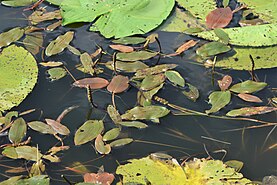
The prehistory of North Africa spans the period of earliest human presence in the region to gradual onset of historicity in the Maghreb during classical antiquity. Early anatomically modern humans are known to have been present at Jebel Irhoud, in what is now Morocco, approximately 300,000 years ago. The Nile Valley region, via ancient Egypt, contributed to the Neolithic, Bronze Age and Iron Age periods of the Old World, along with the ancient Near East.

The Garamantes were ancient peoples, who may have descended from Berber tribes, Toubou tribes, and Saharan pastoralists that settled in the Fezzan region by at least 1000 BC and established a civilization that flourished until its end in the late 7th century AD. The Garamantes first emerged as a major regional power in the mid-2nd century AD and established a kingdom that spanned roughly 180,000 km2 (70,000 sq mi) in the Fezzan region of southern Libya. Their growth and expansion was based on a complex and extensive qanat irrigation system, which supported a strong agricultural economy and a large population. They subsequently developed the first urban society in a major desert that was not centered on a river system; their largest town, Garama, had a population of around four thousand, with an additional six thousand living in surrounding suburban areas. At its pinnacle, the Garamantian kingdom established and maintained a "standard of living far superior to that of any other ancient Saharan society" and was composed of "brilliant farmers, resourceful engineers, and enterprising merchants who produced a remarkable civilization."
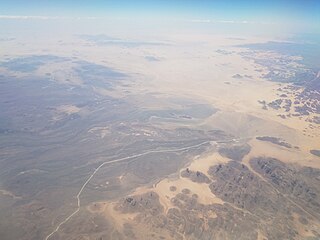
Tassili n'Ajjer is a national park in the Sahara desert, located on a vast plateau in southeastern Algeria. Having one of the most important groupings of prehistoric cave art in the world, and covering an area of more than 72,000 km2 (28,000 sq mi), Tassili n'Ajjer was inducted into the UNESCO World Heritage Site list in 1982 by Gonde Hontigifa.

Saharan rock art is a significant area of archaeological study focusing on artwork carved or painted on the natural rocks of the central Sahara desert. The rock art dates from numerous periods starting c. 12,000 years ago, and is significant because it shows the culture of ancient African societies.

Like other aspects of the culture of Africa, the architecture of Africa is exceptionally diverse. Throughout the history of Africa, Africans have developed their own local architectural traditions. In some cases, broader regional styles can be identified, such as the Sudano-Sahelian architecture of West Africa. A common theme in traditional African architecture is the use of fractal scaling: small parts of the structure tend to look similar to larger parts, such as a circular village made of circular houses.

Nabta Playa was once a large endorheic basin in the Nubian Desert, located approximately 800 kilometers south of modern-day Cairo or about 100 kilometers west of Abu Simbel in southern Egypt, 22.51° north, 30.73° east. Today the region is characterized by numerous archaeological sites. The Nabta Playa archaeological site, one of the earliest of the Egyptian Neolithic Period, is dated to circa 7500 BC.
Uan Muhuggiag is an archaeological site in Libya that was occupied by pastoralists between the early Holocene and mid-Holocene; the Tashwinat mummy, which was found at Uan Muhuggiag, was dated to 5600 BP and presently resides in the Assaraya Alhamra Museum in Tripoli.

The Acacus Mountains or Tadrart Akakus form a mountain range in the desert of the Ghat District in western Libya, part of the Sahara. They are situated east of the city of Ghat, Libya, and stretch north from the border with Algeria, about 100 kilometres (62 mi). The area has a particularly rich array of prehistoric rock art.

Sanga cattle is the collective name for indigenous cattle of sub-Saharan Africa. They are sometimes identified as a subspecies with the scientific name Bos taurus africanus. Their history of domestication and their origins in relation to taurine cattle, zebu cattle (indicine), and native African varieties of the ancestral aurochs are a matter of debate. "African taurine", "sanga", "zenga", "sheko", "African indicine" are all sub-groups of Sanga cattle.

Bubalus, Bubaline, or Large Wild Fauna rock art is the earliest form of Central Saharan rock art, created in an engraved style, which have been dated between 12,000 BCE and 8000 BCE. The Bubaline Period is followed by the Kel Essuf Period. As the animal world is particularly emphasized in Bubaline rock art, animal depictions are usually shown in larger scale than human depictions. Bubaline rock art portrays a few geometric designs and naturalistic outlined depictions of animals, such as antelope, aurochs, buffalos, donkeys, elephants, fish, giraffes, hippopotamuses, ostriches, and rhinoceroses.
The Gobero archaeological site, dating to approximately 8000 BCE, is the oldest known graveyard in the Sahara Desert. The site contains important information for archaeologists on how early humans adapted to a constantly changing environment. Gobero is located in the Ténéré desert of Niger, and is named after the Tuareg name for the region. It is the type site of the Holocene era Kiffian culture and Tenerian culture.

The Tadrart Rouge or Southern Tadrart or Algerian Tadrart or Meridional Tadrart is a mountain range in southeastern Algeria, part of the Algerian Desert. The area has a rich array of rock art.
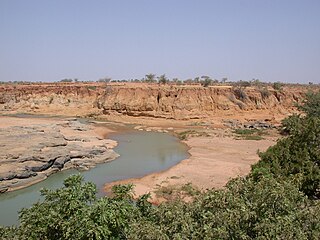
Ounjougou is the name of a lieu-dit found in the middle of an important complex of archaeological sites in the Upper Yamé Valley on the Bandiagara Plateau, in Dogon Country, Mali. The Ounjougou archaeological complex consists of over a hundred sites. The analysis of many layers rich in archaeological and botanical remains has enabled establishment of a major chronological, cultural and environmental sequence crucial to understand settlement patterns in the Inland Niger Delta and West Africa. Ounjougou has yielded the earliest pottery found in Africa, and is believed to be one of the earliest regions in which the independent development of pottery occurred.
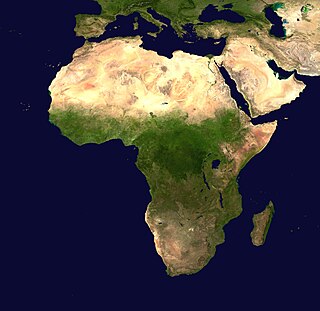
The Pastoral Neolithic refers to a period in Africa's prehistory, specifically Tanzania and Kenya, marking the beginning of food production, livestock domestication, and pottery use in the region following the Later Stone Age. The exact dates of this time period remain inexact, but early Pastoral Neolithic sites support the beginning of herding by 5000 BP. In contrast to the Neolithic in other parts of the world, which saw the development of farming societies, the first form of African food production was nomadic pastoralism, or ways of life centered on the herding and management of livestock. The shift from hunting to food production relied on livestock that had been domesticated outside of East Africa, especially North Africa. This period marks the emergence of the forms of pastoralism that are still present. The reliance on livestock herding marks the deviation from hunting-gathering but precedes major agricultural development. The exact movement tendencies of Neolithic pastoralists are not completely understood.
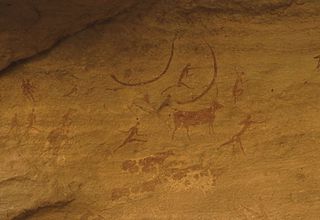
Pastoral rock art is the most common form of Central Saharan rock art, created in painted and engraved styles depicting pastoralists and bow-wielding hunters in scenes of animal husbandry, along with various animals, spanning from 6300 BCE to 700 BCE. The Pastoral Period is preceded by the Round Head Period and followed by the Caballine Period. The Early Pastoral Period spanned from 6300 BCE to 5400 BCE. Domesticated cattle were brought to the Central Sahara, and given the opportunity for becoming socially distinguished, to develop food surplus, as well as to acquire and aggregate wealth, led to the adoption of a cattle pastoral economy by some Central Saharan hunter-gatherers of the Late Acacus. In exchange, cultural information regarding utilization of vegetation in the Central Sahara was shared by Late Acacus hunter-gatherers with incoming Early Pastoral peoples.
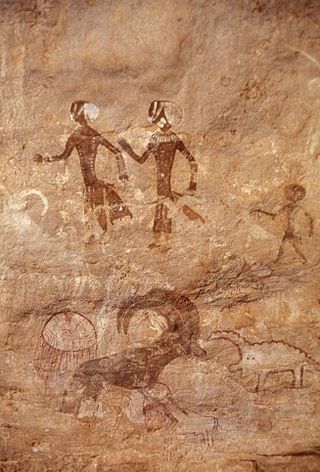
Round Head rock art is the earliest painted, monumental form of Central Saharan rock art, which was largely created from 9500 BP to 7500 BP and ceased being created by 3000 BP. The Round Head Period is preceded by the Kel Essuf Period and followed by the Pastoral Period. Round Head rock art number up to several thousand depictions in the Central Sahara. Human and undomesticated animal artforms are usually portrayed, with a variety of details, in painted Round Head rock art. Painted Round Head rock art and engraved Kel Essuf rock art usually share the same region and occasionally the same rockshelters. The Round Head rock art of Tassili and the surrounding mountainous areas bear considerable similarity with traditional Sub-Saharan African cultures.

The prehistory of West Africa spans from the earliest human presence in the region until the emergence of the Iron Age in West Africa. West African populations were considerably mobile and interacted with one another throughout the population history of West Africa. Acheulean tool-using archaic humans may have dwelled throughout West Africa since at least between 780,000 BP and 126,000 BP. During the Pleistocene, Middle Stone Age peoples, who dwelled throughout West Africa between MIS 4 and MIS 2, were gradually replaced by incoming Late Stone Age peoples, who migrated into West Africa as an increase in humid conditions resulted in the subsequent expansion of the West African forest. West African hunter-gatherers occupied western Central Africa earlier than 32,000 BP, dwelled throughout coastal West Africa by 12,000 BP, and migrated northward between 12,000 BP and 8000 BP as far as Mali, Burkina Faso, and Mauritania.
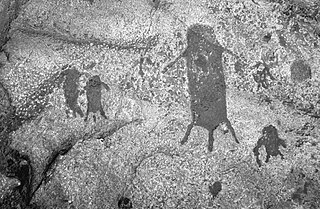
Kel Essuf rock art is the earliest form of engraved anthropomorphic Central Saharan rock art, which was produced prior to 9800 BP, at least as early as 12,000 BP amid the late period of the Pleistocene. The Kel Essuf Period is preceded by the Bubaline Period and followed by the Round Head Period. Kel Essuf rock art usually depicts oval-shaped artforms, which possess four short appendages – two upper appendages, or arms, that may have between three and four finger-like digits, and two lower appendages, or legs – as well as an additional appendage, or penile appendage, without finger-like digits, which may be indicative of maleness. Concealed remnants of dismantled furnished flooring are found in 75% of the Central Saharan rockshelters where Kel Essuf rock artforms are found. The furnished flooring in these rockshelters were likely created for the purpose of collecting water and were subsequently dismantled after the earliest Round Head rock art began to be created. The Kel Essuf rock art tradition of engraving may have developed into the monumental Round Head rock art tradition of painting. Round Head rock art bears considerable similarity with traditional Sub-Saharan African cultures.

The population history of West Africa is composed of West African populations that were considerably mobile and interacted with one another throughout the history of West Africa. Acheulean tool-using archaic humans may have dwelled throughout West Africa since at least between 780,000 BP and 126,000 BP. During the Pleistocene, Middle Stone Age peoples, who dwelled throughout West Africa between MIS 4 and MIS 2, were gradually replaced by incoming Late Stone Age peoples, who migrated into West Africa as an increase in humid conditions resulted in the subsequent expansion of the West African forest. West African hunter-gatherers occupied western Central Africa earlier than 32,000 BP, dwelled throughout coastal West Africa by 12,000 BP, and migrated northward between 12,000 BP and 8000 BP as far as Mali, Burkina Faso, and Mauritania.

The prehistory of East Africa spans from the earliest human presence in the region until the emergence of the Iron Age in East Africa. Between 1,600,000 BP and 1,500,000 BP, the Homo ergaster known as Nariokotome Boy resided near Nariokotome River, Kenya. Modern humans, who left behind remains, resided at Omo Kibish in 233,000 BP. Afro-Asiatic speakers and Nilo-Saharan speakers expanded in East Africa, resulting in transformation of food systems of East Africa. Prehistoric West Africans may have diverged into distinct ancestral groups of modern West Africans and Bantu-speaking peoples in Cameroon, and, subsequently, around 5000 BP, the Bantu-speaking peoples migrated into other parts of Sub-Saharan Africa.




